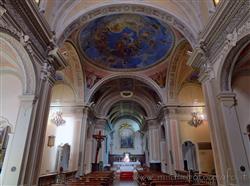|
Gaglianico (Biella)- Parish church of St. Peter
|
|
|
Show to visit in the Biella area: |
 The parish church of St. Peter has medieval origins, but the current church is from the late Baroque period, with quite a few even more recent elements. The parish church of St. Peter has medieval origins, but the current church is from the late Baroque period, with quite a few even more recent elements.
HISTORY
The oldest document in which the church is mentioned dates back to 1207. Originally it was not a parish church and was dependent on the Pieve of Biella.
Starting from when, in the late Middle Ages, it became a parish church, the parish priest was always appointed by the lords of the fiefdom to which Gaglianico belonged.
In 1520 the fiefdom that included Gaglianico became the property of the Ferrero Fieschi family. They were very generous and donated various works of art of different kinds to the church.
The replacement of the original church with the current version began in the seventeenth century. The new church was created by master builders from Biella.
Still in the seventeenth century the central part and some extensions were rebuilt. The construction of the new bell tower began in 1727 and continued until around the middle of the century.
Shortly before the middle of the eighteenth century (1741), construction of the late Baroque façade also began, designed by Giovanni Siletti from Mongrando and completed only in 1877, when it was plastered.
The new façade was erected further forward than the previous one, so as to lengthen the church by about 10m.
The new church was finally consecrated in 1884.
STRUCTURE
The church is characterized by the elaborate two-order façade, typically Baroque even if completed only in the second half of the nineteenth century. Vertically it is punctuated by pilasters placed on a high plinth and in front of which, in the central part, there are in addition columns completely detached from the wall. The structure of the facade is enlivened by the fact that the more lateral parts are placed in a progressively more backward position and by the presence of curved lines in the cornice that divides the two orders and in the window in the center of the upper order.
There are three entrances, one central and two lateral ones, the first with a double frame, the second ones with a single frame.
The church is completely plastered on the outside, with the exception of the exposed brick bell tower, on which the clock was added there in 1737.
The interior has a structure that reflects the expansion coinciding with the creation of the new facade. In fact, there is a central nave, two large side chapels close to the presbytery which could also be seen as a transept, especially considering that the roof between them is formed by a large frescoed dome, and two spaces on the sides of the central nave towards the façade which could also be defined as both chapels and side naves (since each space comprehends two spans with cross vault).
This second part corresponds to the expansion that took place in conjunction with the construction of the new facade. And in fact we observe a discontinuity in the multiple frame that runs along the entire internal perimeter and separates the walls from the vaults: in correspondence with the part corresponding to the expansion the frame is moved higher by almost half a meter.
The central nave has a barrel vault with lunettes, with neoclassical vegetal-themed decorations divided into panels. The same type of decoration is also found on the vaults of the side naves.
The dome between the two chapels is instead decorated with an Assumption of Mary in an intensely blue sky populated by cherubs and angels. The four evangelists are depicted on the pendentives.
In the right side nave there is a wooden confessional built by Antonio Mosca in 1736.
In the left side nave there is a precious baptismal font consisting of a stone basin and an elaborate wooden pyramid created in 1770 by Germano Serra.
Of the two chapels, the one on the right is dedicated to the Souls of Purgatory. The altar dates back to 1725, with subsequent modifications. The beautiful stucco retable with an architectural structure frames an altarpiece by Guglielmo Ciardi from the second half of the nineteenth century depicting the Souls of Purgatory.
The chapel on the left is dedicated to the Virgin of the Rosary, with an altar in fake polychrome marble.
The presbytery and choir form a rather deep rectangular space. The barrel vault with lunettes has the same structure of that of the central nave, although it is narrower.
On the back wall hangs a large canvas within a sumptuous gilded stucco frame. It depicts St. Peter and was painted by Guglielmo Ciardi in 1880. On the side walls hang two large nineteenth-century canvases by Antonio Ciancia.
The wooden choir stalls date back to 1922.
The church has recently enjoyed a radical restoration of the interior.
Categories: Places of historical value of artistic value
Via XX Settembre, 4, 13894 Gaglianico BI |
Parish church of St. Peter: Further pictures in the section Photography |